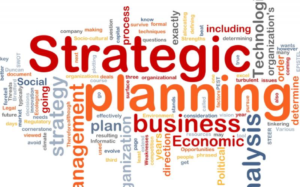Effective Business Plan: Strategic Planning
“Failure to plan is planning to fail”. So managers should have a business plan as one of the many tools to run a successful business. Developing an effective strategic plan that makes optimum use of the resources at their disposal can be difficult for some. So, I will highlight different approaches to come up with “THE PLAN” by using basic strategic planning techniques.

Strategic planning
Definition
Strategic planning is an organizational management activity that sets priorities and focuses energy and resources. It also strengthens operations and ensures that employees and other stakeholders are working toward common goals. Planning also establishes agreements around intended outcomes/results, and assess and adjust the organization’s direction in response to a changing environment. It is also a disciplined effort that produces fundamental decisions and actions. It shapes and guides what an organization is, who it serves, what it does, and why it does it. A strategic plan focuses on the future. Effective planning defines where an organization is going and the actions needed to make progress, as well as how it will know if it is successful.
Methodologies and Framework
There are many different frameworks and methodologies for strategic planning and management. While there are no absolute rules regarding the right framework, most follow a similar pattern and have common attributes. Many frameworks cycle through some variation on some very basic phases:
- analysis or assessment, developing an understanding of the current internal and external environments.
- strategy formulation, developing a high-level strategy and documenting a basic organization level strategic plan.
- strategy execution, translating the high-level plan into more operational planning and action items.
- evaluation or sustainment/management phase, where ongoing refinement and evaluation of performance, culture, communications, data reporting, and other strategic management issues occurs.

Strategic planning is a process and thus has inputs, activities, outputs and outcomes. This process, like all processes, also has constraints. It may be formal or informal and is typically iterative, with feedback loops throughout the process. Some elements of the process are continuous. While others are distinct projects with a definitive start and end date. Strategic planning provides inputs for strategic thinking, which guides the actual strategy formation. Therefore the end result is the organization’s strategy, including a diagnosis of the environment and competitive situation, a guiding policy on what the organization intends to accomplish, and key initiatives or action plans for achieving the guiding policy.
Tools and Techniques
There are a variety of analytical tools and techniques available, developed over time by other organizations. They help provide a framework for strategic planning and include such tools as:
- PEST analysis, which covers the remote external environment elements such as Political, Economic, Social and Technological (PESTLE adds legal/regulatory and ecological/environmental);
- Scenario planning, originally used in the military and recently used by large corporations to analyze future scenarios.
- Porter five forces analysis, which addresses industry attractiveness and rivalry through the bargaining power of buyers and suppliers and the threat of substitute products and new market entrants.
- SWOT analysis, which addresses internal strengths and weaknesses relative to the external opportunities and threats.
- Growth-share matrix, which involves portfolio decisions about which businesses to retain or divest.
- Balanced Scorecards and strategy maps, which creates a systematic framework for measuring and controlling strategy.
- Responsive Evaluation, which uses a constructivist evaluation approach to identify the outcomes of objectives, which then supports future strategic planning exercises.
Criticisms
Strategic planning has been criticized for attempting to systematize strategic thinking and strategy formation. Henry Mintzberg, an internationally renowned academic and author on business and management, argues that inherently creative activities involving synthesis or “connecting the dots” cannot be systematized. He also says that strategic planning can help coordinate planning efforts and measure progress on strategic goals, but that it occurs “around” the strategy formation process rather than within it. Further, strategic planning functions remote from the “front lines” or contact with the competitive environment (i.e., in business, facing the customer where the effect of competition is most clearly evident) may not be effective at supporting strategy efforts.
Regardless of your approach, a properly prepared and executed strategic plan is a valuable resource for your business. In this article Strategic Planning Part 1: Preparation, we focused more on the approach to preparing a business plan. So in Strategic Planning Part 2: Execution, we will talk about how to make your plan operational by defining action steps and success metrics during the implementation phase. Stay tuned!
I have sourced my information from:


